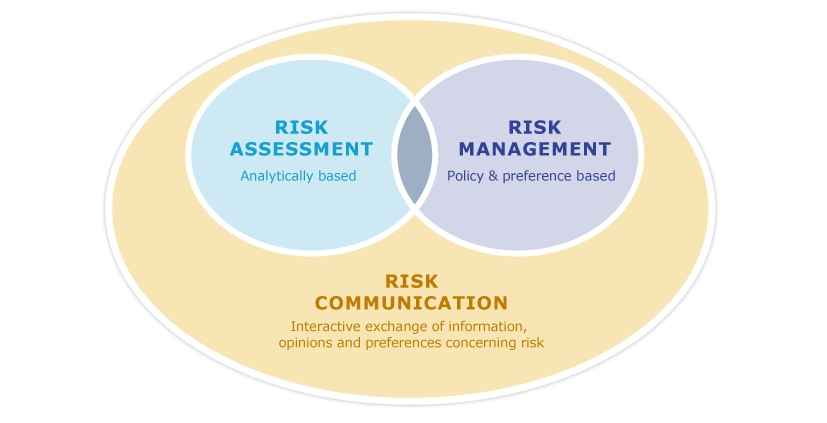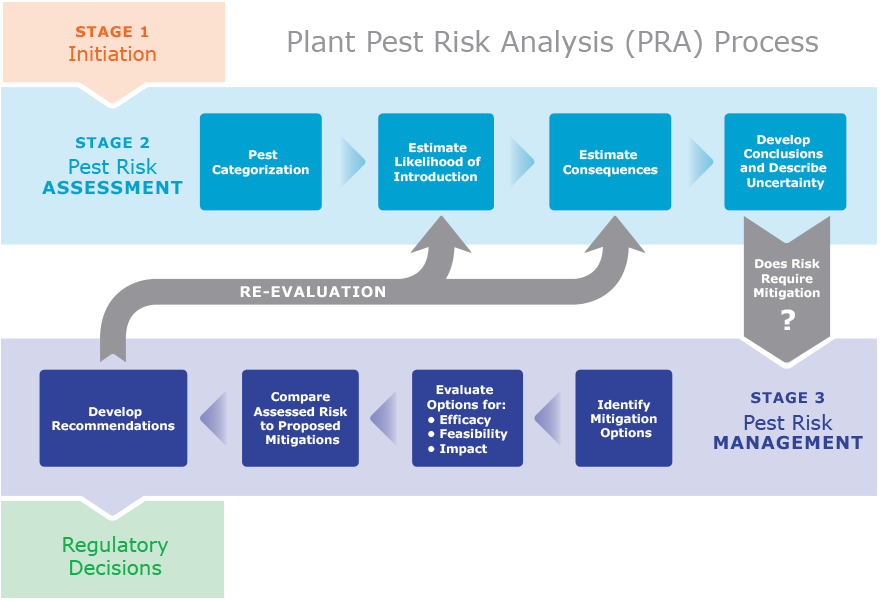Lesson 1: Risk Management Theory and Background
Topic 1: What is Risk Management?
What Is Risk Management? This topic will answer that question for you.
Objectives:
- Be able to explain how risk management and risk assessment are connected.
- Understand the basic framework of plant pest risk management.
- Be able to define terms associated with risk management analysis, practice, and decision-making.
Introduction
Before you can manage a situation, you must be able to measure it to know how bad it is. This common management wisdom appears here, at the beginning of the Plant Pest Risk Management module, to remind you of the close and necessary relationship between assessing risk and managing risk. The diagram below illustrates the connections between the different parts of risk analysis, shows their interdependence, and poses the basic questions that each part seeks to answer. Hover the mouse on each part to explore these connections.

Risk Assessment
You first need to understand the plant health risk—especially how severe it is—before you can focus on ways to manage or reduce the risk. You determine the risk by using a science-based process that addresses these questions:
- What is the risk?
- What is the likelihood of occurrence?
- What are the consequences if the risk is realized?
- What conclusions can you draw?
- What are the uncertainties?
Risk Management
Risk assessment begins by identifying possible hazards. Once hazards are recognized, risk management begins by identifying measures to mitigate the risks associated with those hazards. Ideally, the pest risk assessment document will guide risk management. Risk management addresses the following questions:
- What can, or should be, done about the risk identified in the risk assessment?
- Can something be done to reduce the risk? Sometimes the answer is, nothing can be done!
- What are the options for reducing the risk?
- What are the trade-offs and impacts of each option?
- Which is the best option and why?
- What are the uncertainties?
Risk Communication
As you learned in Module 4, risk communication is an essential tool in PRA. Risk communication helps everyone involved to better understand the risk. It may involve only a few people—for example, communication among risk assessors or between risk assessors and risk managers during the development of a PRA. Risk communication can also bring together larger groups of individuals, such as communications campaigns aimed at customers or stakeholders.
The diagram (Figure 1) below—Plant Pest Risk Analysis (PRA) Process—should already be familiar to you. It was discussed in the previous module. This diagram shows the close relationship between risk assessment and risk management.
Figure 1

Please watch the following video clip for an illustration of the relationship between Stage 2 pest risk assessment and Stage 3 pest risk management.
What to Do if Risk Management Is Needed
As a risk manager, you should
- read and understand the risk assessment.
- identify appropriate risk management options based on the risk assessment.
- seek information on the efficacy, feasibility, and impacts of each option.
- document the level to which the risk is reduced by each option or combination of options.
- re-examine the risk assessment in light of the risk management options chosen.
- consider whether other options leading to the same or equivalent reduction in risk are available.
- demonstrate the added effect of each option on the level of risk reduction.
Evaluate Current Risk Management Practices
Sometimes risk management includes evaluating, or re-evaluating, established measures. The purpose is to determine if the measures are still appropriate and if any adjustments are needed. This monitoring process is important in connecting a PRA to the real world and in validating and improving the process.
Remember!
Risk management, like risk assessment, relies on scientific evidence and expert judgment. However, in some definitions, documents, and reports, the term “risk management” is associated with procedures and activities that are clearly not analytical. For example, risk management may include operational aspects of implementation, or the process of risk management decision-making. These aspects involve taking action rather than going through a scientific process.
Risk Management: Analysis, Practice and Decision Making
Risk management can include the following:
- Risk management analysis: the analytical process of identifying, evaluating, and recommending pest risk management options.
- Risk management practice: the operational aspects of implementing programs and activities to manage pest risk.
- Risk management decision-making: the policy-based process of deciding and prescribing measures to mitigate pest risk.
This module emphasizes the first process—risk management analysis. Only a summary of risk management practices will be provided to demonstrate where measures such as inspections and treatments fit in with the entire process. You will learn more details about implementing risk management practices in later modules.
This module will not discuss risk management decision-making. The reason is that risk management decision-making represents the point where analytical and scientific evidence begins to mix with political, social, and other factors not directly related to pest risk. However, you should know that many of the analytical tools and information used in risk management analysis are also useful operationally. Much of what we know about how well programs work comes from feedback gained when pest risk measures are implemented.
Watch the following video for an overview of the pest risk management analysis process.
This basic process will be shown throughout the rest of the module, and each step will be discussed in more detail in the upcoming lessons and topics.
To continue, select Topic 2 from the Topics menu above or click here.